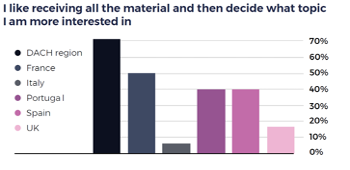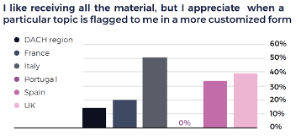
A new year, and the first, early signs of Spring are starting to emerge, along with a cautious sense of optimism: despite volatile markets and a troubling geopolitical backdrop, it feels like the massive impact of COVID on our daily lives is starting to recede, perhaps for good.
But it’s clear that life has changed permanently, and many things simply will not go back to the way they were before. This is certainly true for corporate communicators in financial services firms, as we discovered last year in the first part of our research into how the pandemic is affecting our sector.
Part Two of our study went on to look at how things have changed for the media. We polled 76 journalists from leading publications across Europe, to understand how the pandemic has affected their work, and how PRs should respond.
Content is king
Although the responses varied from country to country, some clear trends quickly emerged. In terms of the kind of content journalists valued most highly, comments on market scenarios ranked as most-preferred overall, followed by insights and case studies.
Press releases, on the other hand, ranked fourth and were identified as the least-preferred option by 50% of respondents. Though, of the group, British and French journalists were more open to receiving these than their counterparts in other countries.
In terms of quality and specificity of information, 62% of those polled claimed to prefer receiving all types of content and then picking out the most interesting parts themselves, while 38% said they prefer receiving less, but more informative, content.


Finally, 30% indicated that they appreciate it when particular topics are suggested to them in a more personal and customised way.
Digital future
During the pandemic, it came as no surprise to discover social media platforms increased their influence alongside traditional channels. Although many journalists did not see social media as being the future of communication within the financial sector, almost 40% of respondents believed this channel gained influence during the pandemic and acknowledged its relevance for their activities.
The shift from in-person meetings and conferences to digital ones, imposed by the pandemic, was considered useful or kind of useful by 67% of respondents, although 20% felt that improvements are needed for these tools to become a new standard.
70% of the journalists we spoke to said they thought online conferences and webinars are here to stay, and are likely to gain influence over time. Where interviews and meetings are concerned, however, the overwhelming majority of respondents believe there will be a mix between digital and in-person interactions, when it comes to media relations.
Efficient PR
We added a few questions at the end of the survey to measure how journalists perceived the work done by PR agencies.
A majority of journalists said they regularly contact PR agencies, although again we see differences between countries, with Spanish and French reporters being more reliant on PR professionals. Half of respondents (51%) said they were satisfied with the kind of information and quality of service provided by PR agencies.
55% of respondents ranked efficiency as the most appreciated characteristic of PR professionals, particularly in France, Portugal and UK. Italian journalists tended to value creativity, proactivity and knowledge of the financial sector equally.
Ever-changing
People never tire of proclaiming the end of traditional news, and the demise of PR with it, but these surveys show that even in a time of great challenge and change, quality news and top-notch PR continue to be valued highly.
But we can’t get complacent: as ever, the ecosystem of journalists and PRs continues to evolve, and communicators have to respond and adapt to make sure their approach matches the needs of journalists today. Same old, same old just doesn’t cut it in the new normal.


